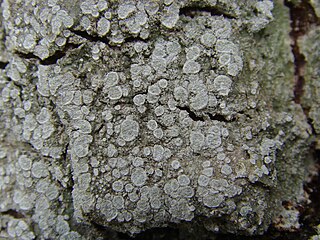
Diorygma is a genus of lichenized fungi in the family Graphidaceae. The genus was circumscribed by Franz Gerhard Eschweiler in 1824. Species of the genus are widely distributed in tropical and subtropical regions of the world.

Enterographa is a genus of lichens in the family Roccellaceae.

Bulbothrix is a genus of lichen-forming fungi in the family Parmeliaceae. This genus is synonymous with Bulbothricella V.Marcano, S.Mohali & A.Morales. Bulbothrix was circumscribed by lichenologist Mason E. Hale in 1974 with Bulbothrix semilunata as the type species.

Pertusaria is a large genus of warty crustose lichens in the Pertusariaceae family. The fruiting bodies are usually modified apothecia that immersed in warts on the main body (thallus) with small holes for the spores to emerge, similar to ostioles, or are fully above and lecanorine (spore bearing discs surrounded by a ring of tissue similar to the tissue of the thallus. Members of the genus are commonly called wart lichens.
André Aptroot is a Dutch mycologist and lichenologist.
Pertusaria diluta is a species of crustose lichen in the family Pertusariaceae, first found in inland rainforests of British Columbia.
Parmotrema acrotrychum is a species of lichen in the family Parmeliaceae. First discovered in Papua New Guinea, it was originally described in 1979 by Japanese lichenologist Syo Kurokawa as a species of Parmelia. Heinar Streimann transferred it to the genus Parmotrema in 1986. The lichen has also been found in Queensland (Australia) and Malaysia. It has been shown to contain a variety of secondary chemicals, including atranorin, fumarprotocetraric acid, succinprotocetraric acid, chloroatranorin, protocetraric acid, protolichesterinic acid, and lichesterinic acid.
Helge Thorsten Lumbsch is a German-born lichenologist living in the United States. His research interests include the phylogeny, taxonomy, and phylogeography of lichen-forming fungi; lichen diversity; lichen chemistry and chemotaxonomy. He is the Associate Curator and Head of Cryptogams and Chair of the Department of Botany at the Field Museum of Natural History.
Alan W. Archer is a mycologist and taxonomist. He is currently an honorary research associate at Royal Botanic Gardens Sydney. He uses chemotaxonomy as well as morphological features in taxonomy and to devise keys, most recently for the genus Pertusaria in the Australasia region.
Pertusaria ambigua is a lichen in the family Pertusariaceae, and found in New South Wales, growing on trees.
Pertusaria guineabissauensis is a species of crustose lichen in the family Pertusariaceae. It was described as a new species in 2019 by Graciela Paz-Bermúdez, Alan Archer, and John Elix. It grows on tree bark, producing a thick greenish-grey thallus with a dull, wrinkled surface. The lichen is characterised by the presence of wart-shaped (verruciform) ascomata, asci that contain eight ascospores arranged in a single row (uniseriate) and the presence of the secondary chemicals stictic and hypostictic acids. The specific epithet refers to Guinea-Bissau, where the lichen was discovered, and its only known locality.
Pertusaria aptrootii is a species of crustose lichen in the family Pertusariaceae. It was described as a new species in 1998 by Alan W. Archer and John Alan Elix. The lichen occurs in Papua New Guinea, and is known from only two specimens collected at the type locality. The type was collected in Varirata National Park at an altitude of 800 m (2,600 ft), where it was found growing on conglomerate rock. It is named after Dutch lichenologist André Aptroot, who collected the type.
Klaus Kalb is a German lichenologist and an authority on tropical lichens.

Salazinic acid is a depsidone with a lactone ring. It is found in some lichens, and is especially prevalent in Parmotrema and Bulbothrix, where its presence or absence is often used to help classify species in those genera.
Pertusaria salazinica is a species of crustose lichen in the family Pertusariaceae. Found in Australia, it was described as a new species in 2017 by lichenologists Alan Archer and John Alan Elix. The type specimen was collected in Tully Gorge National Park (Queensland) at an altitude of 885 m (2,904 ft). Here, in a montane rainforest, it was found growing on a rotting log. The specific epithet refers to the presence of salazinic acid, a major secondary compound in the lichen. It also contains norstictic acid as a major metabolite, and connorstictic acid as a minor metabolite. Pertusaria salazinica is only known from the type specimen.

Lepra is a genus of lichen-forming fungi in the family Pertusariaceae. Although the genus was created in 1777, it was not regularly used until it was resurrected in 2016 following molecular phylogenetic analyses. It has more than 80 species, most of which were previously classified in genus Pertusaria.
Henricus (Harrie) Johannes Maria Sipman is a Dutch lichenologist. He specialises in tropical and subtropical lichens, and has authored or co-authored more than 250 scientific publications. He was the curator of the lichen herbarium at the Berlin Botanical Garden and Botanical Museum from 1983 until his retirement in 2010.
Imshaugia sipmanii is a species of saxicolous (rock-dwelling) lichen in the family Parmeliaceae. Found in Venezuela, it was formally described as a new species in 2004 by Australian lichenologist Jack Elix. The species epithet honours Dutch lichenologist Harrie Sipman, who collected the type specimen.





